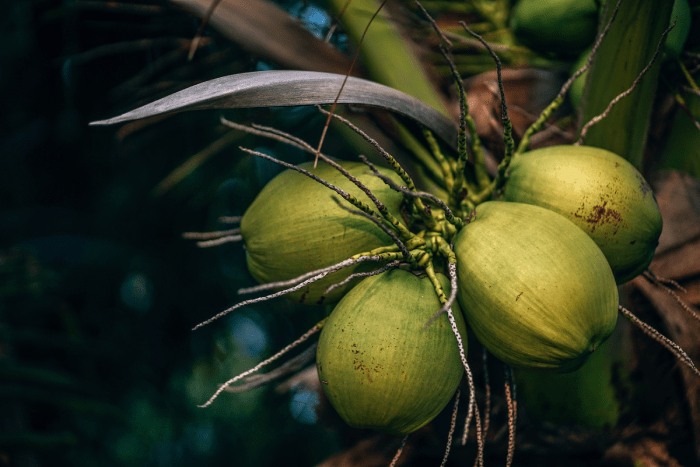
Anywhere you go in the Philippines, from the lengthy coastal areas surrounding the more than 7,000 islands comprising the archipelago, to the inland valleys and rolling plains, up to the rugged mountain ranges, solitary hills and volcanoes rising up to the heavens that rig the land, the coconut tree is a ubiquitous presence.
So much so that in any place in the country, from Batanes to Tawi-Tawi, coconuts – that is to say, all the various parts of the coconut – figure in one way or another in the regional/ethno-linguistic cuisine.
So you have the fiery ginataan (savory dishes cooked in coconut cream) that is the distinctive feature of Bicol dishes, or the sweetish and garlicky lumpiang ubod that is the specialty of the Bacolod-Silay area, to name a couple of the more commonly known coconut-themed regional fare. How about grandmas imbibing tuba in the early morning southern sunshine?
But coconuts really do feature in the day-to-day lives of most Filipinos, and mostly in the ordinary, taken-for-granted ways that we almost forget how very tightly our diets (at least, in the pure Filipino sense) are intertwined and based on this tropical palm. We even have various terms for the coconut fruit depending on its level of maturity.
We slake our thirst on the refreshing coconut water, blend it into a cocktail, ferment it into natural vinegar, or take the fermentation a little further to turn it into an alcoholic drink.
We eat the meat straight from the shell, or toast it, or spoon it or break it into strips to mix in salads, or grate it to add flavor to any rice concoction, or sweeten it into macapuno to eat it on its own or again mixed in a fancy dessert.
Even coconut fruits past their prime are valued – they provide the cream in which anything fancied can be cooked, be it a savory or sweet dish. We also have bukayo – sweetened coconut – in all forms, color, texture and style, depending on the region. And of course, mature coconuts provide the meat from which santana, or coconut oil, is expressed. Did you know that coconut oil may yet be the healthiest oil in the world?
And if you think I have run out of edible parts of the coconut, wait just yet. We eat the trunk, too. Well, actually, it’s the young shoots of the tree, called ubod.
Strictly speaking, we are now past the edible parts, since we really don’t eat the next one, but the intricately woven wrapper in which suman, patopat, or puso are encased and steamed come from strips upon strips of young coconut leaves.
And in the rural areas, dried coconut husks are the preferred pang-uling – charcoal – for a proper grill. The “husky” ones, though, are used as floor polish – the manual…errrr…the one-where-you-use-legs kind – kuskos, bunot – giving a good workout for the body and a shiny wooden floor for the house.
On top of this, the coconut is not called the tree of life solely on the basis of the food it provides. Because it also sustains life, by providing its durable trunk – to stand as the foundation of a small nipa hut, or to elevate a batalan in which food is prepared for a meal, and afterwards where the kitchen and dinner utensils are washed.
Essential components that sustain a family, helping turn a house into a home.
And the left-over spines of the leaves are gathered and bound to become walis ting-ting – brooms – to sweep away the camachile or banana peelings, and other litter on the floor or on the lawn. This last has even been transformed into a symbol of unity for the country – inspired by the Filipino proverb Matibay ang walis, sapagkat nabibigkis. Roughly translated, though a bit far-fetched, “there is strength in unity,” but that is the essence of it.
Looking for other Lutong Bahay Recipes to try on? Feel free to check out our ulam recipes, desserts recipes and snacks recipes.
Some visual and written contents are copyrighted to their respective and considerate owners. We do not claim that these recipes or photos are proprietary to us. If this is yours and you would like it to be removed and not shared with others, please let us know by sending an email to contact @ lutongbahayrecipe.com, you may use our website contact form or by sending a message on our Facebook page. Read our disclaimer.







Leave a Reply